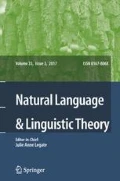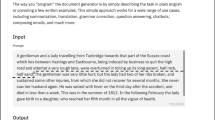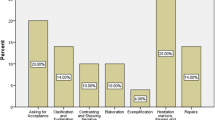Abstract
This paper explores how discourse markers contribute to the update of discourse through a detailed study of Mandarin dique ‘indeed’ and zhende ‘really’. On the basis of empirical data and a naturalness rating experiment, we show that dique and zhende make similar yet different contributions to discourse updates. Dique presupposes that its prejacent issue is old, while zhende presupposes that its prejacent issue is old and that some discourse participant has failed to resolve this issue. Furthermore, dique and zhende can embed both assertions and questions. This supports Farkas and Bruce’s (2010) Table stack model, which provides a uniform treatment for assertions and questions.


Similar content being viewed by others
Notes
A variety of terms are used to refer to this class of expressions, including ‘discourse marker’ (Schiffrin 1987), ‘pragmatic marker’ (Fraser 1996; Brinton 1996), ‘discourse particle’ (Schourup 1985), ‘connective’ (Blakemore 1987), etc. The term ‘discourse marker’ and ‘discourse particle’ are both frequently used. We did not adopt the term ‘discourse particle’ for the words discussed in this study (i.e., dique and zhende), since they are polysyllabic and contain significant phonetic content, and thus do not fit the label ‘particle.’
The Mandarin data reported in this paper are based on the introspection of the first author, who is a native speaker of Mandarin Chinese, unless otherwise noted.
The English data in (7), (8) and (9) are based on the introspection of two English native speakers the authors consulted.
Romero and Han (2004) only present examples containing VP-initial really, but they did not distinguish between sentence-initial and VP-initial really in their discussion of really. Hence we assume that really at both positions is claimed to have the same semantics as the verum operator in their analysis. Therefore, Romero and Han’s (2004) analysis cannot explain why the use of really is infelicitous in (9) unless they propose a different semantics for sentence-initial really from that of the verum operator.
See Section 3.1 for the formal definition of an issue.
We assume that p ‘It will rain’ has not been suggested by anyone in the previous discourse in (28). If some individual has already predicted the rain, as in (17), then the use of dique is felicitous here.
See Section 3.1 for the formal definition of issue resolvement.
The use of zhende indicates that the speaker believes that y’s answer does not resolve I. It does not necessarily indicate that the speaker believes that y’s answer is false. As in (i), C’s answer can be true, i.e., the company is indeed full of beauties. B knows that C’s assertion is true, but B believes that this assertion does not resolve A’s issue.
-
(i)

-
(i)
These two discourse markers make the same contributions in another speech act, i.e., commands, as they do in assertions and questions. See Yuan (2015:208–211) for the discussion of the interaction between dique/zhende and commands.
Qualtrics is a web-based system that conducts online surveys. Version 45634 of the Qualtrics Research Suite. Copyright©2013 Qualtrics. http://www.qualtrics.com.
In this experiment, each participant has seen all target sentences in all kinds of contexts. Hiramatsu (1998) and Snyder (2000) point out that acceptability ratings may be influenced by repeated exposure. The current results can and should be replicated in a follow-up experiment in which separate experimental lists are constructed according to a Latin Square-design, such that each list contains an equal amount of target sentences per context, and each list is judged by an equal number of participants.
See Farkas and Bruce (2010:86–87) for the original definition of the Table stack. Farkas and Bruce (2010) assume that the items on the Table are syntactic objects paired with their denotations. For example, after Anne’s assertion in (46), the syntactic structure (i.e., ‘Sam is home’[D], ‘D’ for the sentential feature of declaratives) and its denotation (i.e., the set {p}, p = ‘Sam is home’) are both added onto the Table. Having syntactic forms available in discourse together with semantic contents allows conversational moves to have access to both of them. For simplicity, the definition in (48) omits the syntactic structure and hence only the denotation (i.e., an issue I) is added onto the Table. See also Isaacs and Rawlins (2008) who make use of the notion of stack to model a context.
See Cohen and Krifka (2014) and Krifka (2015, 2017) for a similar theory of speech acts that models both the current cg and its projected continuation. Their framework characterizes various reactions to different speech acts, e.g., acceptance and rejection of assertions or questions, based on the notion of commitment states and commitment spaces.
Dique and zhende can either occur at sentence-initial position or VP-initial position. This paper only discussed dique/zhende at sentence-initial position. Adverbs at these two positions make similar semantic contributions and both can be analyzed as presupposition triggers. For example, both sentences in (i) indicate that the proposition ‘Li went abroad’ has been suggested, and both sentences in (ii) indicate that p ‘Li went abroad’ has been suggested and that some discourse participant remains uncommitted to the truth of p. See Appendix and Yuan (2015:109–130) for the discussion of a subtle difference between sentence-initial and VP-initial dique/zhende.
-
(i)

-
(ii)

-
(i)
We would like to thank the editor for reminding us that one of the most important advantages of employing Farkas and Bruce’s (2010) theory is that it allows us to analyze dique and zhende as lexical items that affect the discourse updates.
The potential of the framework of Farkas and Bruce (2010) is greater than what have been discussed above. Other pieces of work which adopt this model include Farkas (2011) on imperatives, Chernilovskaya (2014) on exclamatives, Müller (2014) on German modal particles, Malamud and Stephenson (2015) on tag questions, etc.
References
Beaver, David, and Emiel Krahmer. 2001. A partial account of presupposition projection. Journal of Logic, Language and Information 10: 147–182.
Blakemore, Diane. 1987. Semantic constraints on relevance. Oxford: Blackwell.
Brinton, Laurel J. 1996. Pragmatic markers in English: Grammaticalization and discourse functions. Berlin: de Gruyter.
Chernilovskaya, Anna. 2014. Exclamativity in discourse: Exploring the exclamative speech act from a discourse perspective. PhD diss., Utrecht University.
Cohen, Ariel, and Manfred Krifka. 2014. Superlative quantifiers and meta-speech acts. Linguistics and Philosophy 37: 41–90.
Coniglio, Marco. 2008. Modal particles in Italian. University of Venice Working Papers in Linguistics 18: 91–129.
Coniglio, Marco, and Iulia Zegrean. 2010. Splitting up force evidence from discourse particles. University of Venice Working Papers in Linguistics 20: 7–33.
Cowart, Wayne. 1997. Experimental syntax: Applying objective methods to sentence judgments. Thousand Oaks: Sage Publications.
Farkas, Donka F. 2011. Polarity particles in English and Romanian. In Romance linguistics 2010: Selected papers from the 40th linguistic symposium on Romance linguistics, ed. Julia Herschensohn, 303–328. Amsterdam: Benjamins.
Farkas, Donka F., and Kim B. Bruce. 2010. On reacting to assertions and polar questions. Journal of Semantics 27 (1): 81–118.
Fraser, Bruce. 1996. Pragmatic markers. Pragmatics 6: 167–190.
Grosz, Patrick. 2014. German doch: An element that triggers a contrast presupposition. In Chicago Linguistic Society (CLS) 46, 163–177.
Gunlogson, Christine. 2001. True to form: Rising and falling declaratives as questions in English. PhD diss., University of California Santa Cruz.
Han, Chung Hye. 1998. The structure and interpretation of imperatives: Mood and force in universal grammar. PhD diss., University of Pennsylvania.
Heim, Irene. 1982. The semantics of definite and indefinite noun phrases. PhD diss., University of Massachusetts, Amherst.
Heim, Irene. 1991. Artikel und Definitheit [Articles and definiteness]. In Semantik: Ein internationales Handbuch der zeitgenossischen Forschung, eds. Arnim von Stechow and Dieter Wunderlich, 487–535. Berlin: de Gruyter.
Hiramatsu, Kazuko. 1998. Natural classes of subjacency violations: Evidence from syntactic satiation. General examination paper, Department of Linguistics, University of Connecticut, Storrs.
IBM. 2011. IBM SPSS statistics for Windows, version 20.0. Armonk: IBM Corp.
Isaacs, James, and Kyle Rawlins. 2008. Conditional questions. Journal of Semantics 25: 269–319.
Karagjosova, Elena. 2004. The meaning and force of German modal particles. Saarbrücken dissertations in computational linguistics and language technology.
Karagjosova, Elena. 2006. Correction and acceptance by contrastive focus. In Brandial 2006, the 10th workshop on the semantics and pragmatics of dialogue, 26–33. Potsdam: University of Potsdam.
Karttunen, Lauri. 1974. Presuppositions and linguistic context. Theoretical Linguistics 1: 181–194.
Kaufmann, Magdalena, and Stefan Kaufmann. 2012. Epistemic particles and performativity. In Semantics and Linguistic Theory Conference (SALT) 22, ed. Anca Chereches, 208–225.
Krifka, Manfred. 2015. Bias in commitment space semantics: Declarative questions, negated questions, and question tags. In Semantics and Linguistic Theory Conference (SALT) 25, eds. Sarah D’Antonio, Mary Moroney, and Carol Rose Little, 328–345. New York: Linguistic Society of America and Cornell Linguistics Circle.
Krifka, Manfred. 2017. Negated polarity questions as denegations of assertions. In Contrastiveness in information structure, alternatives and scalar implicatures: Studies in natural language and linguistic theory, vol. 91, eds. Chungmin Lee, Ferenc Kiefer, and Manfred Krifka. Cham: Springer.
Li, Charles N., and Sandra A. Thompson. 1981. Mandarin Chinese: A functional reference grammar. Berkeley: University of California Press.
Liu, Yuehua, Wenyu Pan, and Wei Gu. 2004. Shiyong xiandai hanyu yufa [Practical modern Chinese grammar], 2nd edn. Beijing: Commercial Press.
Malamud, Sophia A, and Tamina C. Stephenson. 2015. Three ways to avoid commitments: Declarative force modifiers in the conversational scoreboard. Journal of Semantics 32 (2): 275–311.
McCready, E. 2008. What man does. Linguistics and Philosophy 31 (6): 671–724.
McCready, E., and Malte Zimmermann. 2011. Particles (Lecture notes). In ESSLLI 2011.
Müller, Sonja. 2014. Zur Anordnung der Modalpartikeln “ja” und “doch”: (In)stabile Kontexte und (non)kanonische Assertionen. Linguistische Berichte 238: 165–208.
Potts, Christopher. 2007. Logic for linguists. Course for LSA institute. Available at http://www.christopherpotts.net/ling/teaching/lsa108P/. Accessed 30 October 2018.
Qi, Huyang. 2002. Yuqici he yuqi xitong [Mood particles and mood system]. Hefei: Anhui Education Press.
Roberts, Craige. 1996. Information structure: Towards an integrated formal theory of pragmatics. In OSU working papers in linguistics, vol. 49, eds. Jae Hak Yoon and Andreas Kathol, 91–136. Columbus: OSU Department of Linguistics.
Romero, Maribel, and Chung-hye Han. 2004. On negative yes/no questions. Linguistics and Philosophy 27 (5): 609–658.
Schiffrin, Deborah. 1987. Discourse markers. Cambridge: Cambridge University Press.
Schourup, Lawrence C. 1985. Common discourse particles in English conversation. New York: Garland.
Schütze, Carson T. 1996. The empirical base of linguistics: Grammaticality judgments and linguistic methodology. Chicago: University of Chicago Press.
Snyder, William. 2000. An experimental investigation of syntactic satiation effects. Linguistic Inquiry 31 (3): 575–582.
Stalnaker, Robert. 1978. Assertion. Syntax and Semantics 9: 315–332.
Yuan, Mengxi. 2015. Mandarin discourse adverbs as presupposition triggers. PhD diss., City University of Hong Kong.
Yuan, Mengxi, and Yurie Hara. 2012. The semantics of Mandarin assertion modifier dique and zhende. In Sinn und Bedeutung 17, eds. Vincent Homer, Emmanuel Chemla and Grégoire Winterstein, 617–634.
Zeevat, Henk. 2004. Particles: Presupposition triggers, context markers or speech act markers. In Optimality theory and pragmatics, eds. Reinhard Blutner and Henk Zeevat, 91–111. London: Palgrave McMillan.
Zhang, Yisheng. 2000. Xiandai hanyu xuci [Function words in Modern Chinese]. Shanghai: East China Normal University Press.
Acknowledgements
We are sincerely grateful to the editors and three anonymous reviewers whose feedback on earlier versions has tremendously helped improve this paper. Special thanks are also due to Satoshi Tomioka and Stefan Kaufmann, who introduced us to Farkas and Bruce’s (2010) framework. We are also grateful to Christopher Davis, Michael Yoshitaka Erlewine, Magdalena Kaufmann, Paul S. Law, Po Lun Lee Peppina, Elin McCready, Haihua Pan, Kyle Rawlins, Uli Sauerland and Grégoire Winterstein for their constructive criticism and valuable comments. This research was supported by the Fundamental Research Funds for the Central Universities (Grant number 17JNQN007) awarded to Mengxi Yuan and JSPS KAKENHI (C) Grant Number 18K00589 awarded to Yurie Hara.
Author information
Authors and Affiliations
Corresponding author
Appendix A: Adverbs at sentence-initial and VP-initial positions
Appendix A: Adverbs at sentence-initial and VP-initial positions
A difference between sentence-initial and VP-initial dique/zhende is that VP-initial adverbs can be embedded but sentence-initial ones cannot:
-
(86)

In this paper, a sentence-initial adverb is defined as a sentential force modifier, which takes a force head as its argument. This correctly predicts that sentence-initial adverbs cannot be embedded, as clauses indicating sentential forces cannot be embedded in Mandarin. As pointed out by Han (1998), there are many languages in which embedded clauses cannot express force. This is indeed the case in Mandarin. Mandarin clauses marked as questions or commands cannot be embedded. When it appears that these clauses are embedded, they are in fact direct quotations. For example, ni xihuan wo ma in (87) is a direct quotation of the question ‘Do you like me’ uttered by Li, and ni lai wo jia ba in (88) is a direct quotation of the command ‘Come to my home’ uttered by Li.
-
(87)

-
(88)

In contrast, VP-initial dique can be defined as a propositional modifier, which can be embedded:
-
(89)
λα.α〈T(c)[0] ={α}〉, and α is of type 〈s,t〉
The different denotations correctly predict that sentence-initial dique can occur in a wh-question, whereas VP-initial dique cannot, as in (90). According to (89), VP-initial dique must take a single proposition of type 〈s,t〉 as an argument. Semantically, wh-questions are composed of a set of propositions (of type 〈〈s,t〉,t〉) and a force head. Therefore, VP-initial dique is not compatible with wh-questions, and hence (90b) is ungrammatical. In contrast, sentence-initial dique can take a set of propositions as its argument, and thus (90a) is grammatical. See Yuan (2015) for the detailed discussions on the differences between sentence-initial and VP-initial dique/zhende.
-
(90)

Rights and permissions
About this article
Cite this article
Yuan, M., Hara, Y. Guiding assertions and questions in discourse. Nat Lang Linguist Theory 37, 1545–1583 (2019). https://doi.org/10.1007/s11049-018-9435-y
Received:
Accepted:
Published:
Issue Date:
DOI: https://doi.org/10.1007/s11049-018-9435-y











